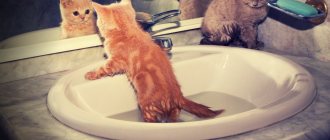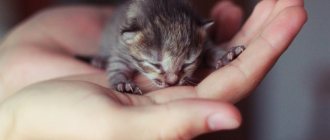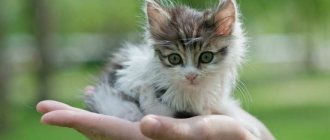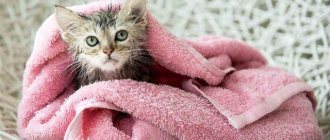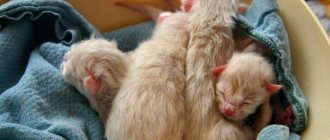11666Administration
3
When the touching moment comes of the appearance of a couple of months old fluffy ball in the house, a huge responsibility immediately falls on the shoulders of its new owners. And those who believe that it is enough to “feed and put the baby to sleep” are deeply wrong.
Caring for a 2-month-old kitten means not only providing a roof over your head, food and a cozy place, but also many procedures to maintain your pet’s health:
- developing a diet special for a 2-month-old baby;
- toilet training, litter box care;
- care for teeth, ears and eyes;
- vaccination;
- nail care;
- the washing up;
- grooming (especially if the kitten has long hair);
- games.
All this must be done so that the kitten at 2 months is truly well-groomed, healthy and feels love from its new family.
Diet
Nutrition for a two-month-old kitten is a powerful guarantee of its energy, activity and overall health.
Therefore (regardless of the breed) the baby must be fed fully. A well-designed menu is a mandatory inclusion in the pet’s diet of necessary products or truly healthy food, as well as the refusal of food that is harmful to the kitten, which can seriously undermine its health.
© shutterstock
General feeding recommendations
If a kitten is switched to natural feeding, food from the owner’s table should under no circumstances be offered to it. You will have to cook individually for your pet. Lean meat and poultry, fermented milk products, vegetables, grains (including sprouted ones) will be very useful; sometimes you can offer sea fish (also not fatty).
You should not treat your pet to ocean fish, any bones, whole milk, potatoes and pasta, and also exclude salty, smoked and spicy foods.
A 2 month old kitten should receive food 5-6 times a day. At the same time, food should not be cold or hot, or salty. Products must only be fresh.
If feeding a kitten at 2 months is based on ready-made food, the following conditions must be met:
- You only need to buy packages marked “for kittens.”
- The food should not be cheap (it does more harm than good) or canned (such food can be given to an adult cat).
- Ideally, purchase products from one manufacturer so that the kitten already eats a balanced diet at 2 months.
- It is forbidden to mix dry and wet food: digesting each of them takes different times, and it will be very difficult for a small stomach to cope.
- If the “drying” is too large, it is better to soften it in water until it becomes mushy.
Water must be available at all times, especially when using ready-made dry food. The water is changed once a day for fresh water.
The dishes must also be taken care of. You need to wash it often so that leftover food does not dry out in it and spoil. Ideally, immediately after the kitten has eaten. Bowls should be stable and heavy (so that they do not crawl away from the pet while eating).
Diapers
Many mothers choose disposable diapers for their baby.
But this is not the only possible option.
Here's what you can choose from:
- Reusable nappies;
- Disposable diapers;
- Reusable diapers;
- Waterproof diapers.
You can try everything: disposable diapers for sleeping and walking, and reusable diapers for waking (the option becomes relevant at an older age, for example, from the moment the baby begins to actively crawl), and swaddling in the form of panties in the hot season, and disposable or waterproof diapers for air baths for newborns.
You have to solve another difficult question: which diaper manufacturer should you choose? The solution to this issue is also possible only through experience. To find out which manufacturer’s diapers your baby is more comfortable in, you can buy products from different companies individually to try. Considering the age of the newborn, you won’t have to rack your brains over the size: all manufacturers have a “Newborn” position in the size chart; this diaper is designed for a baby’s weight from 2 to 5 – 6 kg. When choosing a particular manufacturer, pay attention to the elastic bands and Velcro of the diapers: they should not be hard.
The best diaper expert is your baby
The best expert in choosing diapers is the baby himself. He can always tell you if something is wrong. A child who is suitable for the hygiene and care products you use is not capricious, sleeps peacefully and is happy while awake. His skin is dry, without irritation or streaks from Velcro and rubber bands. He doesn't try to pull off his diaper. From the entire range of modern diapers, you can choose the quality that will be ideal for your baby.
Do diapers need to be changed at night?
During the day, it is recommended to change the diaper every 2 to 3 hours and try to avoid breaks of 4 hours or more. The question of whether to change a diaper at night is resolved very simply: if it is not full and clearly does not cause discomfort to the child, there is no need to change it. The baby will most likely wake up if the diaper is full, and then all questions will be resolved by themselves. Please note that there are special night diapers that are more absorbent; they allow the baby to be dry during sleep and sleep soundly.
How to change a diaper?
It’s not complicated, we offer you step-by-step instructions:
- We spread two clean diapers (disposable or a combination of waterproof and cotton on top) on the changing table.
- We put the baby in diapers.
- Unfasten and unfold the used diaper.
- Carefully lift the baby by the legs with one hand, clasping them by the shins closer to the ankle, and remove the used diaper with the other.
- We remove the feces with a damp cloth and wash the baby’s skin with running water (remember that you need to wash the girl strictly from front to back, so as not to spread infection to the genitals).
- We remove the top diaper if it is dirty and place the baby on the table.
- Dry the skin, carefully wiping all folds.
- After cleansing, apply cream to the skin in the diaper area.
- We place an unrolled clean diaper under the baby’s buttocks, lower his legs, fasten the diaper, gluing the Velcro fasteners to the colored strip of the diaper. You did it!
Toilet training
In a new home, a small kitten may well “fine” out of habit, and this is forgivable at first. But it’s better to start accustoming him “to his place” on the very first day.
To do this, it is necessary to take proper care of the litter box: it should always be clean and large enough for the kitten to sit comfortably in it.
Also, when getting used to the toilet, special sprays will help, thanks to which the kitten will already be able to figure out “where it is possible and where it is not possible” already at 2 months:
- Training (spray directly into the tray).
- Repellent (apply to those places where the baby has done something wrong).
The main thing is not to scold or punish your pet for mistakes at first, and then, having felt kindness and patience on the part of the person, the kitten, even at 2 months, will quickly get used to the litter box.
© shutterstock
Feeding young children
In order for the baby to develop according to his age, it is necessary to properly organize his nutrition. This food should provide the baby’s body with the necessary amount of energy and nutrients.
Feeding mode
According to WHO recommendations, a baby should be put to the breast from the first day of life at any sign of hunger. Thus, in the first days of the baby’s life, the frequency of feeding can reach 10-15 times per day. This is also called free feeding mode. Then, as the baby grows, the frequency of feeding decreases and in the second or third week it is about 6-7 times per day. According to the recommendations of leading pediatricians in Russia, healthy full-term children after birth (after discharge from the maternity hospital) are given a six-time feeding regimen with an interval of 3.5 hours. After 6 months of life, a five-time feeding regimen is established with an interval of 4 hours.
It is important to adhere to the feeding schedule.
Calculation of the amount of nutrition required for a child of the first year of life
In the first ten days of a newborn’s life, the daily volume of formula or breast milk can be calculated using a certain formula:
The amount of milk per day = 0.02 * body weight at birth * day of life of the baby . That is, we multiply two percent of body weight at birth by the number of days of life.
After 10 days of life, the daily amount of milk is calculated by the “volumetric” Geubner–Czerny method . To use this method, you need to learn how to calculate the child’s proper body weight. It is calculated by monthly increments: to the weight at birth we add 600 g for 1 month, 800 g for 2 and 3, 750 g for the 4th, 700 g for the 5th and so on up to 12 months). That is, 50 g less for subsequent months. Then, having calculated the baby’s proper body weight, we use the following rule:
- From 10 days to 2 months, the baby should receive a daily amount of food in the amount of 1/5 of the required body weight.
- From 2 to 4 months – 1/6.
- From 4 to 6 months – 1/7.
- After 6 months, healthy children receive a daily nutritional volume of 1000 ml.
After 6 months, the child begins to be given new foods. There are food additives and complementary foods . Nutritional supplements are not included in the daily food intake. These include: juices, fruit puree, yolk, crackers, cookies, wheat bread. Complementary feeding dishes are taken into account in the daily amount of food and gradually replace breastfeeding. The first complementary foods begin to be introduced from 6.5 months to 7 months. Second feeding from 7.5 months to 8 months. Third complementary feeding from 8.5 months to 9 months. Complementary feeding dishes include: vegetable puree, milk-cereal or milk-cereal porridge, meat puree, cottage cheese, fish dishes. Now there are programs for introducing foods to children earlier.
Teeth cleaning
2 months is the age when it is easiest to teach a kitten to brush its teeth. The later you start, the more difficult it will be to force your pet to endure the execution.
It is enough to take care of your pet’s teeth only 1-2 times a month; the rest of the time, the kitten cleans off the plaque itself by gnawing on solid food (dry croquettes, chicken or meat cartilage, etc.).
When caring for your teeth, it is better to use special brushes and pastes with the smell and taste of your favorite foods that are attractive to pets, as this makes it much easier to get used to the procedure. You can buy everything you need at veterinary pharmacies.
Advice: it is better to end each dental care session with praise and treats to reinforce the training effect.
Proper care of a kitten 1 month old
To care for newborn kittens, it is better to be close to a mother cat who will happily feed her babies and provide proper care. Natural nutrition with breast milk will strengthen the animal’s immunity and nourish the body with all the necessary microelements for full development and growth.
If for some reason a 1-month-old kitten is forced to grow up without a mother, the owners of the tiny pet need to create the most favorable conditions in the house. You need to feed your baby a special formula - a cat's milk substitute.
After feeding, the mother cat licks the kitten, which improves intestinal motility. This procedure can be replaced in this way: a cotton pad is moistened with warm water, after which the face is carefully wiped. Next, the abdominal area, back and sides are treated with circular movements without pressure. This will improve the functioning of the digestive system and normalize the stool of a small pet.
Newborn animals have a relatively low body temperature, so at night, provide his sleeping place with a warming device. You can use a small infrared lamp to maintain the optimal temperature. It needs to be installed so that in case of strong heating, the kitten can move and lie down in another, cooler place.
Eye cleaning
A healthy kitten's eyes are always moist. But if dry crusts appear in the inner corners, pus is a sign of disease. In this case, eye care is necessary. The accumulations are removed with a napkin soaked in boric acid or in a solution of furatsilin (as prescribed by a veterinarian) in the direction from the outside to the nose.
With normal lacrimation, eye care does not require special products from the pharmacy. It is enough to rinse in the same direction (towards the nose) with regular tea leaves or chamomile decoction.
Advice: when carrying out the procedure, it is better not to use cotton swabs or pads, as individual fibers get into the eyes and cause discomfort, which will make further eye care problematic.
Ear cleaning
Ear care for kittens at 2 months does not need to be done frequently, as their shells are usually still clean. But checks for the presence of earwax (dark spots) should be carried out from time to time. Dirt should be removed as needed with a cotton swab lubricated with oil or cosmetic Vaseline.
When cleaning, you should not try to insert the stick deep into the ear; it is enough to remove accessible stains. When carried out properly, almost every kitten tolerates the procedure calmly . This procedure is not only hygienic, but also an excellent preventive measure against ear mites. Cleaning should be done individually (depending on how dirty it is), but on average – once a month.
© shutterstock
Claws
In principle, you can do nothing at all with claws, if you don’t feel sorry for the furniture upholstery. Otherwise, you will have to wean your pet from the habit of tearing up everything. You can do this in several ways:
- buy a scratching post, spray it with catnip that is attractive to these pets, and teach how to use it by smoothly running your paws with extended claws over the surface of the device (often scratching posts are already sold impregnated with special compounds to attract the attention of cats);
- put caps on the claws and monitor the kitten’s reaction (whether it will be comfortable for him to wear them);
- trim the claws, cutting the length no more than 1 mm from the edge, so as not to cause pain to the kitten.
These measures will be enough to try to protect furniture upholstery and wallpaper from tearing.
the washing up
There is no need to wash your pet often; once every 1 or 2 months is enough. In order for the kitten to get used to water faster, it is important to provide him with comfortable washing:
- lay a rag on the bottom so that the paws do not move apart;
- make the water temperature about 38 C;
- depth - to the middle of the paws;
- the stream should be thin;
- be sure to stroke and talk to your pet affectionately (since the first bath can frighten the baby);
- Use a special shampoo for cats and rinse it off thoroughly.
The basic rule is that when washing, do not wet the kitten’s head, ears and eyes . After the procedure, wrap the animal in a soft towel and dry the fur, and then do not let the dry pet into drafts.
© shutterstock
Wool
Shiny and soft fur is an indicator of the health of the animal. In order for her to always look “excellent”, she will need comprehensive care:
- balanced diet;
- keeping the kitten clean (timely washing);
- and actually caring for your pet’s fur coat – combing with special combs and combs (not human ones).
To care for a 2-month-old kitten’s fur, it is important to meet all of the above conditions.
Recommendation: a comb, with its teeth, penetrates the hair much deeper than a comb, so when using it, you should not apply pressure.
Games and relaxation
Each kitten should have its own place to sleep and rest. You can buy or make a small house or soft bedding with your own hands, or perhaps the little pet of the whole family will like a chair or your old fur coat - here the kittens’ preferences are individual. Your task is to make sure that there are no drafts in the room where the kitten lives.
As for toys, buy durable balls, balls, and rodents that your baby won’t be able to chew and swallow. Many kids love to run after a laser pointer, play with balls of thread, and candy wrappers. You can build a real “buffet wall” for your baby with ladders and cozy beds - this will be his play and sleeping space, in which he will feel like a master.
A kitten in the house is great happiness and joy, and the little troubles of caring for it are more than compensated by the affection that the pet will give you and your loved ones.
